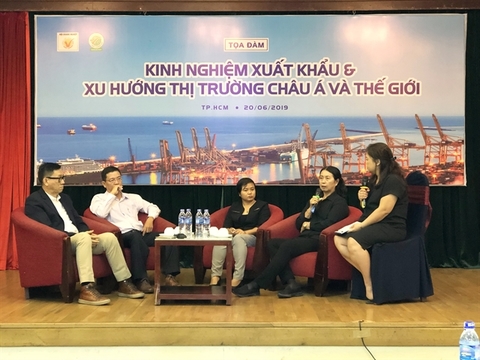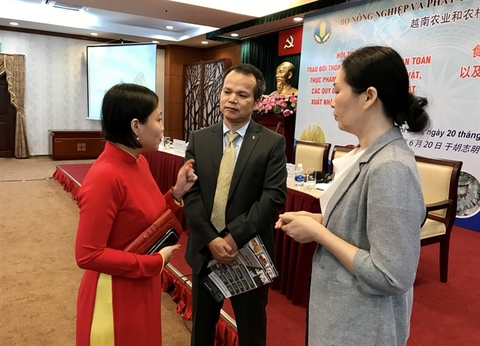At Asanzo ‘manufacturing’ factory, Chinese parts are made into ‘Vietnamese’ products
At Asanzo ‘manufacturing’ factory, Chinese parts are made into ‘Vietnamese’ products
As part of an exposé that discovered Asanzo Vietnam importing Chinese products and disguising them as locally made merchandise for sale, Tuoi Tre (Youth) newspaper witnessed first-hand the process of assembling China-imported parts into finished products labeled as “made in Vietnam with Japan technology” inside a ‘manufacturing’ plant of the electronics firm.
Asanzo has two plants in Ho Chi Minh City, one at the Vinh Loc Industrial Park in Binh Tan District and the other at Tan Binh Industrial Park in the namesake district.
The factory at Vinh Loc is considered the manufacturing center of Asanzo Vietnam. But there are only assembling activities at the facility, with workers busily making ‘made-in-Vietnam’ TVs and air conditioners from Chinese parts, a ‘manufacturing’ process that also involves removing the ‘made-in-China’ stamps on the main components.
While Asanzo TVs and air conditioners are assembled in Vietnam, the company has been discovered bringing home appliances in the form of finished products from China to sell in the country under the guise of Vietnamese goods.
Huge imports of Chinese parts
On April 8, Tuoi Tre reporters witnessed Le Quang, a company headquartered in District 12, and Van Doan Co., located in District 7, clearing customs for many containers of electronics parts shipped from China at Cat Lai port.
Both companies later had their products transported to the Asanzo factory at Vinh Loc Industrial Park.
In one of the containers imported by Le Quang were six different types of TV components, shipped by Xin Ying Global Co. from the Chinese province of Guangzhou, while 402 LCD panels, shipped by Hong Kong Kangguan Technology, were seen being loaded out of one of the shipments imported by Van Doan.
Le Quang has imported hundreds of thousands of TV components from China in the first four months of this year, according to documents reviewed by Tuoi Tre. Similarly, Van Doan brought to Ho Chi Minh City from China more than 128,000 TV parts, mostly LCD panels in the same period.
Asanzo has said it sold more than 160,000 air conditioners during the peak of this year's hot season. The company does not manufacture any air-con components in Vietnam, so where the parts were from?
On April 24, Tran Thoan Co. cleared customs for six containers worth of such air conditioner parts as heaters, condensers and compressor motors, shipped by Ningbo Aux Import & Export, at Cat Lai port. The company later imported five more containers of these products.
Most of these air conditioner parts were transported to the Asanzo factory at Vinh Loc.
It is at this facility that the TV and air conditioner components, all imported from China, are assembled into finished products that will be sold as Vietnamese goods manufactured using Japanese technology in the domestic market.
Six steps to make a TV
In early April, Tuoi Tre reporters went undercover as assembling workers at the Asanzo factory at Vinh Loc Industrial Park.
Your correspondents managed to land the job even after telling the recruiter that they had no knowledge or experience in electronics.
The job was in fact simpler than one expects from an electronics manufacturing factory.
Here, about 200 employees working on 12 assembly lines will follow a six-step procedure to make ‘made-in-Vietnamese’ TVs from Chinese components.
The process starts with placing the circuit board onto the LCD panel, followed by wiring, back panel installing and screwing. The two last steps are checking and stamp labeling.
One of the most important things to do during the assembling process is to remove the “made in China” stamps placed on the LCD panels.
According to the assembling manual by Asanzo, a worker in charge of the third step in the above process is responsible for placing an Authenticated Stamp Guaranty (ASG) stamp onto every LCD panel to cover the "made in China" text on the original one before installing the back panel.
However, in reality, your correspondents were told to remove the "made in China" stamps rather than overlaying them. The removal method involves applying adhesive tape to the stamp and pull the tape off in the opposite direction. This helps ‘erase’ the “made in China” part on the stamp rather than completely removing the stamp. But that’s enough.
After erasing the stamp, the worker in charge of this step will go on to place the back panel onto the product and proceeds to the next step in the assembly line, no matter how badly torn the original stamp is.
Your correspondents have bought an Asanzo 32” LED TV from a store in Ho Chi Minh City and opened the product to check the LCD panel inside. There, a stamp was found damaged in the same fashion as what your correspondents witnessed at the Vinh Loc factory, meaning no “made in China” was visible from the stamp.
The ‘disguising process’ is much simpler at the Asanzo factory at Tan Binh Industrial Park, where workers only have to assemble parts into finished products such as electric ovens, and place ASG stamps on the products.
According to Vietnamese law, air conditioners imported as finished products are subject to a special consumption tax and a state quality control process. Importing parts for later assembly is a deliberate act of the importer to evade taxes and the required quality check.


















